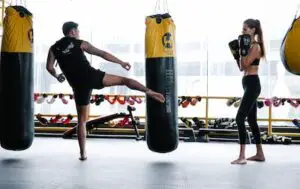Capoeira Ficag, an exhilarating martial art originating from Brazil, has captured the hearts of enthusiasts around the globe. Infused with elements of dance, acrobatics, and music, Capoeira Ficag offers a unique and captivating experience. In this comprehensive guide, we will delve into the fascinating world of Capoeira Ficag, exploring its origins, techniques, benefits, and cultural significance.
The Roots of Capoeira Ficag: An Enigmatic History
Capoeira Ficag finds its origins in the struggles of African slaves in Brazil during the colonial era. To preserve their cultural traditions and develop a form of self-defense against their oppressors, enslaved Africans disguised their martial arts training with rhythmic movements, creating what we now know as Capoeira. Capoeira Ficag emerged as one of the many styles within the diverse world of Capoeira.
Uniting Movements and Music: The Heartbeat of Capoeira Ficag
Capoeira Ficag is characterized by its mesmerizing blend of fluid movements, acrobatics, and music. Capoeiristas engage in a game called “Jogo,” where two participants interact through a series of strategic and rhythmic movements. The music, played by a small ensemble of traditional instruments such as the berimbau, pandeiro, and atabaque, sets the tempo and energy of the game, creating a dynamic and vibrant atmosphere.
Essential Techniques in Capoeira Ficag: The Art of Agility and Precision
a) Ginga: The foundation of Capoeira Ficag, the ginga is a constant swaying movement that allows capoeiristas to seamlessly transition between attacks and defensive maneuvers.
b) Esquivas: Esquivas are evasive movements crucial for avoiding strikes and maintaining balance during the game. Capoeira Ficag incorporates various types of esquivas, such as the Esquiva Lateral (lateral dodge) and the Negativa (low dodge).
c) Kicks and Strikes: Capoeira Ficag showcases an array of kicks, strikes, and sweeps. From the powerful Martelo (hammer kick) to the graceful Meia Lua de Compasso (spinning crescent kick), these techniques demonstrate the agility, flexibility, and creativity of capoeiristas.
d) Acrobatics: Capoeira Ficag often incorporates breathtaking acrobatic movements, such as flips, cartwheels, and handstands, adding a visually stunning aspect to the art.
The Role of Music and Instruments: Harmonizing the Game
Music is an integral part of Capoeira Ficag, serving as the rhythmic backbone of the game. The berimbau, a single-stringed musical bow, takes the lead, dictating the pace and style of the game. Supporting the berimbau are instruments like the pandeiro (tambourine) and atabaque (drum), which provide the foundational rhythm, enhancing the capoeiristas’ movements and creating an immersive experience.
The Benefits of Practicing Capoeira Ficag: Mind, Body, and Soul
a) Physical Fitness: Capoeira Ficag offers a full-body workout that improves strength, endurance, flexibility, and coordination. The dynamic movements and acrobatics challenge the body, while the continuous flow of the game keeps participants engaged and energized.
b) Self-Expression and Creativity: Capoeira Ficag encourages individual style and self-expression, allowing practitioners to improvise movements within the game. This artistic aspect fosters creativity and helps capoeiristas develop their unique flair.
c) Cultural Appreciation: Through Capoeira Ficag, practitioners connect with the rich cultural heritage of Brazil. It serves as a medium for understanding the history, traditions, and struggles of the African diaspora in the country, fostering cultural appreciation and respect.
d) Mental Well-being: Capoeira Ficag promotes mental well-being by reducing stress, enhancing focus, and fostering a sense of community and camaraderie among practitioners. The rhythmic nature of the game and the social interactions contribute to a positive and uplifting environment.
e) Self-Defense Skills: Capoeira Ficag equips individuals with practical self-defense techniques, teaching them how to react effectively in challenging situations. The fluid movements, evasive maneuvers, and strikes in Capoeira Ficag are applicable in real-life self-defense scenarios.
f) Social Integration: Capoeira Ficag brings people from diverse backgrounds together, fostering inclusivity, teamwork, and social interaction. The community aspect of Capoeira Ficag creates lasting friendships and a supportive network.
Cultural Significance: Capoeira Ficag as a Symbol of Brazil’s Heritage
Capoeira Ficag holds immense cultural significance in Brazil. It represents the resilience, creativity, and strength of the Afro-Brazilian community. Recognized as an Intangible Cultural Heritage of Humanity by UNESCO, Capoeira Ficag stands as a symbol of Brazil’s multicultural heritage, highlighting the blending of African, Indigenous, and European influences.
Conclusion
Capoeira Ficag offers a captivating journey into the world of Brazilian martial arts, combining movement, music, and culture. With its rich history, intricate techniques, and numerous benefits for the mind, body, and soul, Capoeira Ficag presents an immersive and rewarding experience. As you embrace the rhythm, creativity, and community of Capoeira Ficag, you not only embark on a personal journey but also contribute to the preservation and celebration of Brazil’s vibrant cultural heritage. So, step into the roda, feel the music, and let Capoeira Ficag ignite your spirit.





